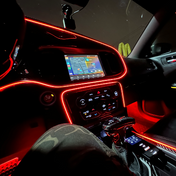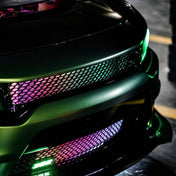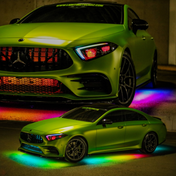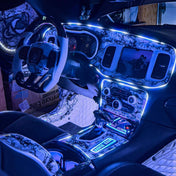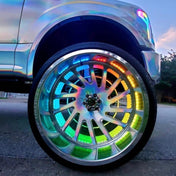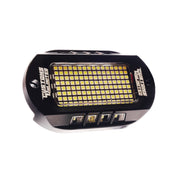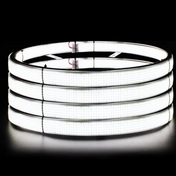Mounting the Halos
1. Thoroughly clean each headlight lens with rubbing alcohol or soapy water
2. Remove adhesive backing from halos and apply directly to the cleaned headlight lens. Ensure that each halo is even and centered on the headlight before applying pressure.
3. Run the wires from the halos thru the top and behind of the front facia that covers each headlight. You will need to remove the black plastic pieces located on top of the bumper and radiator in order to easily feed the wires towards the passenger side of the vehicle, where the fuse box is located.
4. When mounting waterproof fog light halos, be sure to throughly clean the fog light bezel or lenses. To ensure the halos are mounted flush on the bezel or lens, you may consider cutting a small amount of the adhesive backing off where the wires connect to the halos. You may need to access the inner wheel well in order to run the wires to the top of the bumper if you cannot reach them from the top of the bumper. Utilize a wire extension if the wire does not reach the passenger side of the vehicle.
Powering the Wiring Harness
1. Locate the fuse box on the passenger side of the vehicle and find the red "12v+" post on the left of the fuse box. Remove the cover and nut, then slide the connector with the inline fuse (will have red wire under the wire sleeve) onto the 12v+ post. Reapply the nut and cover when complete.
2. Directly above and below the fuse box are two "Frame" ground bolts, which are located on the metal body of the vehicle. Unscrew either of these bolts and slide the connector of the wire that does not contain the inline fuse (will have a black wire under the wire sleeve) onto the frame ground bolt. Reapply the nut when completed. *Note: You can also connect this wire to any part of the metal frame that is free of paint.
*Note: Wiring the halos this way means that you will need to manually turn the halos on and off because they are receiving constant power. The wiring harness can be connected to any 12 volt source or fuse as long as it can supply at least 10 Amps of current. It can also be wired to an inline switch or relay if desired.
Connecting the Halos to the Harness
1. Use the provided wire extensions to extend the wires of the halos on the drivers side of the vehicle if needed
2. Simply connect each halo to any of the male JST connectors on the wiring harness.
3. Connect the handheld or bluetooth controller to the single female JST connector from the wiring harness. DO NOT ATTEMPT TO RUN ADDITIONAL VOLTAGE TO THE BLUETOOTH CONTROLLER. THIS WILL PERMANENTLY DAMAGE THE HARNESS AND HALOS. Place the controller in a relatively cool, dry place away from moisture or direct engine heat. Utilize a wire extension if needed.
Controlling the Halos
1. For our Bluetooth controller, download the Magic-LED app from the App/Google Play store. Ensure that bluetooth is enabled on your smartphone however, DO NOT attempt to connect to the controller thru the devices bluetooth menu. Simply open the Magic-LED app and wait for the app to search for the controller. It should show up as "1" or "SP105E". Click on the controller to begin controlling the halos. Ensure that the settings in the settings menu (located in top right corner of the app) are as follows:
- Set the LED color order to "GRB"
- Set the LED type to SK6812 or WS2812
- Set the LED count to the number of LEDs on the largest halo
2. For the RF Handheld controller, refer to the supplied instruction manual for information on key functions.
*Wiring diagrams listed at end of page*
General Halo Kit Installation
What tools should I have ready when it comes time to install?
- Pry tool / Flathead Screwdriver
- Dremel / Cut Tool / Power Drill
- Epoxy / Superglue Adhesive
- Butyl Rubber Sealant
- Oven (optional) – see mounting options below.
- Beading Wire (optional) – see mounting options below.
- Surgical Powderless Gloves (optional)
How do I open my headlight to install a halo?
This is the tricky part, there are two methods installers use on a daily basis. Regardless of which route you take please refer to a few install videos / tutorials on YouTube before starting just to get familiar with the process. Before anything, you'll want to determine what type of seal is on your headlights, you'll either have a Butyl sealant (which will typically only take 1 cycle in the oven), or a Permaseal (which could possibly require a few cycles in the oven).
-
Method 1: Pre-heat oven to 235°. Remove any metal screws from the lens/housings and place headlight in oven for 12 minutes at a time. Some headlights take more cycles than others. Using a flat head screwdriver you will pry the headlight open in 3” increments until it’s completely loose/detached.
- Method 2: Some prefer to avoid the oven and simply use a dremel or some sort of cutting tool. If you’d rather use a tool you’re going to want to cut along the lens where it meets the plastic of the headlight. Make sure to not cut too deep on your first swipe around or it will melt the plastic and cause buildup around the edges of the headlight.
How do I mount the halo inside of the headlight?
There’s a few ways to go about this:
- Use the 3M adhesive tape found on the backside of your halo ring, be sure to sand the surface you’ll be applying the halos to before doing so.
- You can use your every day 2 part epoxy or superglue: simply spread it along the backside of the halo and stick onto it’s desired location.
- Use the metal wire method, which would require drilling two very small holes on each side of the halo and running wire across the top of the halo and through the holes. Once the wire is ran through and you feel as if the halo is secure, simply twist lock the open ends together on the backside of the headlight until firm.
How do I reseal my headlights once the halos have been installed?
As mentioned above, you'll need to determine what type of housings you are dealing with:
- Butyl Sealed: If your headlights were originally butyl sealed, we recommend you use the same material to re-seal them, however, additional butyl is recommended to ensure they are fully waterproof. It's extremely important that you have the entire outline of your housings sealed to avoid moisture issues.
- Permasealed: Some headlights are originally permasealed, in this case, you'll already have the permaseal removed from previous steps, we recommend you use butyl to re-seal them, simply because it will make life a whole lot easier for you if you have to open them back up for any reason in the future.
How many different components can I hook up to 1 remote?
This is a question we get almost daily, unfortunately there’s not a definitive answer for this. It all depends on which components you’re installing, however, most of our products can all be programmed and synced together, if you’re unsure please contact us prior to ordering and consult with one of our staff members about your specific setup.
Remote Wiring:
Please refer to the diagrams below for help with connecting your remotes properly.





